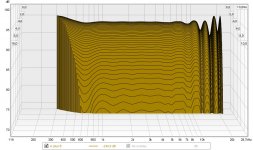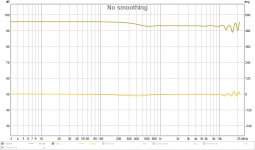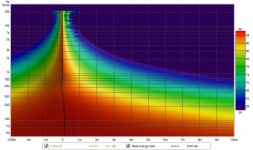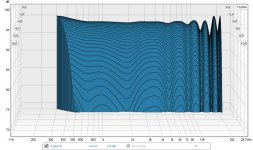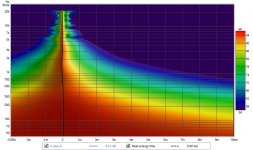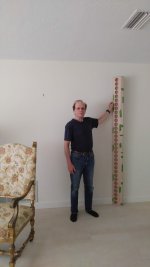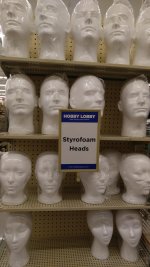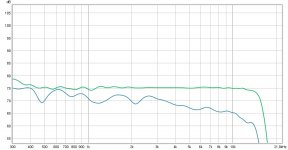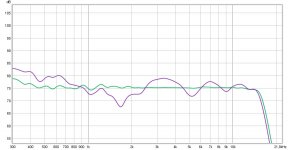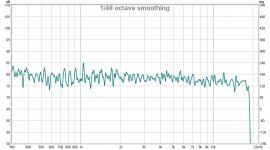I have never realized I could have used so much prose about my tweeter-pods, made back in 2011....

These were made with SLS printing too 😛. Or 'Grown by Lasers'.
Made another set for a friend who finished them with paint:


These were made with SLS printing too 😛. Or 'Grown by Lasers'.
Grown by Lasers.
HYLIXA’s complex cabinet geometry is only possible by harnessing a technique called ‘Selective Laser Sintering’. Each cabinet is ‘grown’ in Node’s laboratory from microscopic Glass Nylon particles, systematically fused by a computer-controlled laser, each 0.2mm layer at a time.
Made another set for a friend who finished them with paint:
Back on track, a little more info about the mid/side EQ (concentrating on mid for now).
I've done a few simulations, as I don't have the house to myself, that's about all I can do.
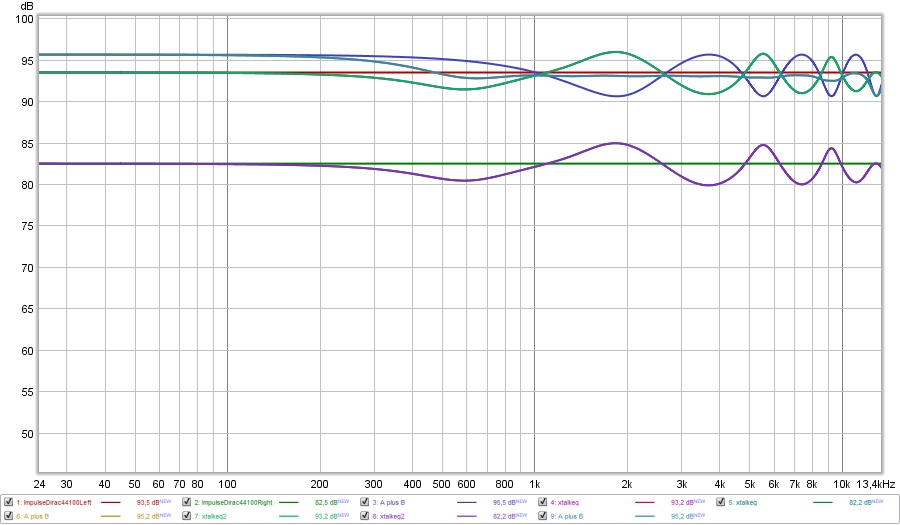
The previous message on this topic showed the sum of two EQ-ed streams, one representing the main signal, the other, 11 dB less in level the later arriving cross talk. Minimum phase EQ.
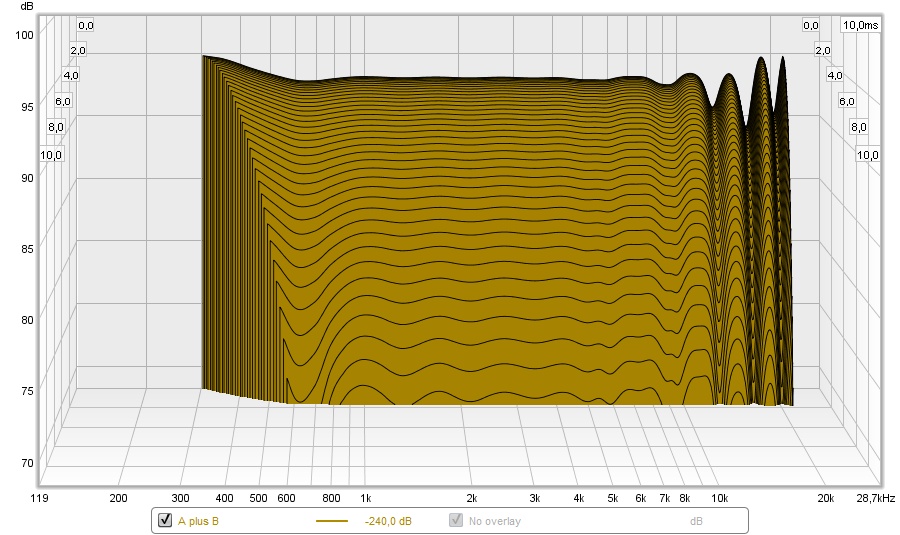
Let's see Frequency/Phase:
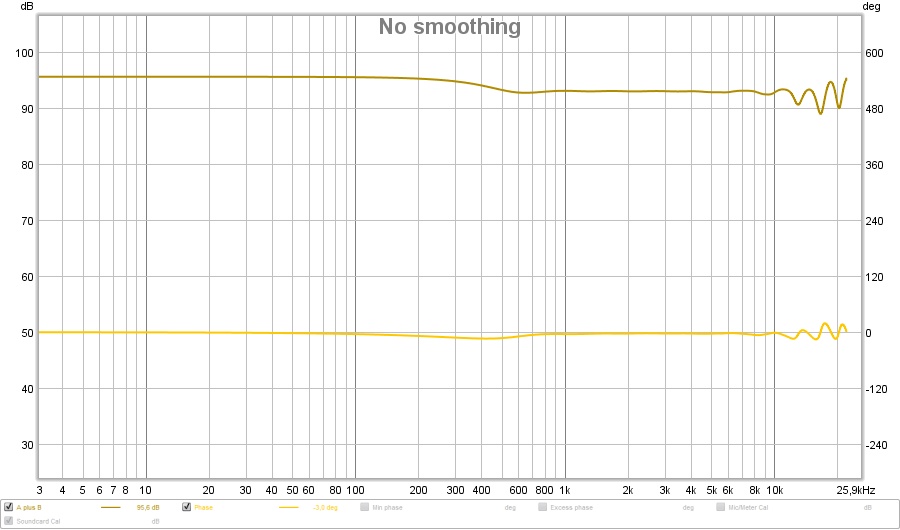
And spectogram/wavelet data:
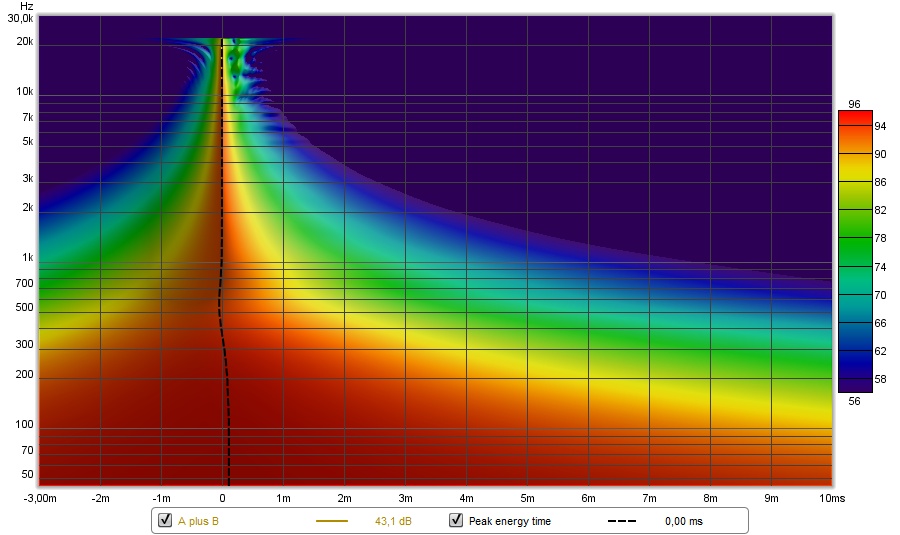
I altered the EQ mode from minimum phase to linear, to see the differences:
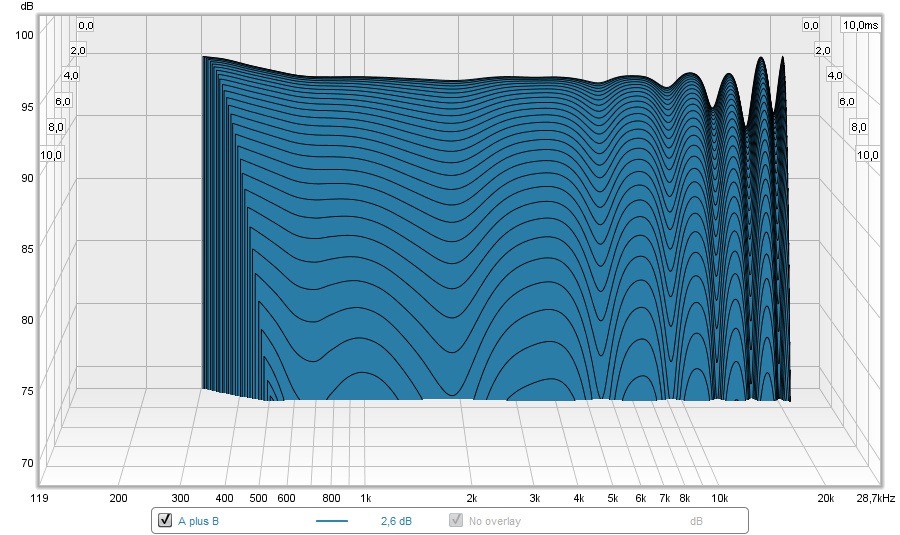
Frequency/Phase:
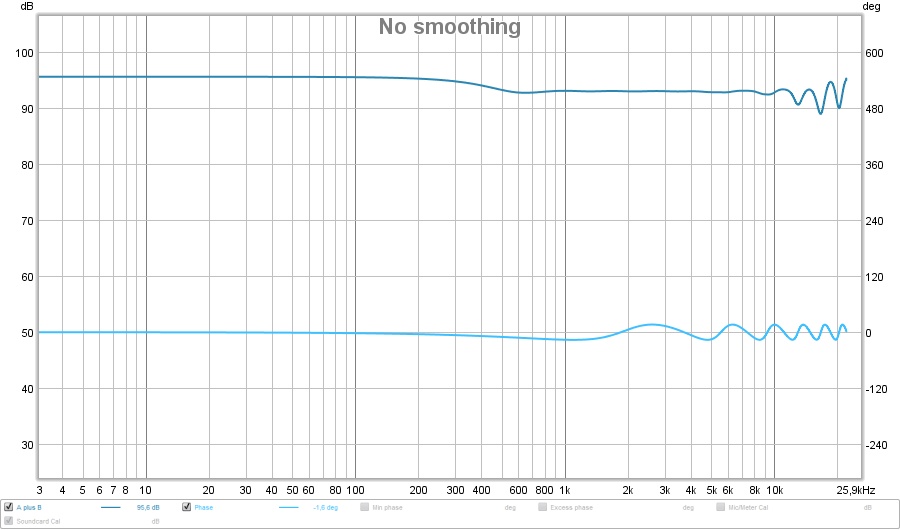
And spectogram/wavelet:
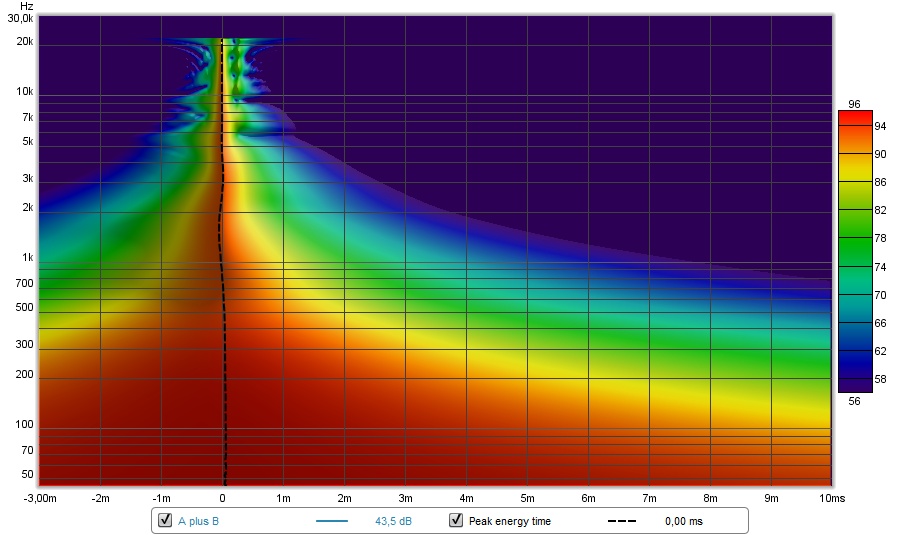
So, the end result FR curve looks identical, except for it's phase trace. The spectogram/wavelet shows the difference the most clear here.
With minimum phase EQ we can restore the phantom sum of main + cross talk back to it's original shape. That is, if we know what the sum looks like.
Another thing to note is the phase wiggle from where I stopped EQ-ing the lower region. My dummy head showed way less head shading there, but the ears actually sum (no dips) at both ears plus that cross talk gets added.
So it will be interesting (to listen) where to stop EQ-ing.
I've done a few simulations, as I don't have the house to myself, that's about all I can do.
The previous message on this topic showed the sum of two EQ-ed streams, one representing the main signal, the other, 11 dB less in level the later arriving cross talk. Minimum phase EQ.
Let's see Frequency/Phase:
And spectogram/wavelet data:
I altered the EQ mode from minimum phase to linear, to see the differences:
Frequency/Phase:
And spectogram/wavelet:
So, the end result FR curve looks identical, except for it's phase trace. The spectogram/wavelet shows the difference the most clear here.
With minimum phase EQ we can restore the phantom sum of main + cross talk back to it's original shape. That is, if we know what the sum looks like.
Another thing to note is the phase wiggle from where I stopped EQ-ing the lower region. My dummy head showed way less head shading there, but the ears actually sum (no dips) at both ears plus that cross talk gets added.
So it will be interesting (to listen) where to stop EQ-ing.
Attachments
It will also be interesting what to do with the side panned sounds. If we EQ the (L+R) there's always left and right content in that mix. After all, it is a clear sum. But to simulate sound comming from hard left (clearly beside you) one would have to remove the cross talk, as that cross talk from a sound coming from 180 degree would no doubt be lower in SPL level. There isn't a conflicting right signal though, like we have/experience with phantom sounds.
And if we do EQ the left side, we do get a negative pulse of the same amount that the EQ had into the right channel. That's going to alter the imaging of those sounds, so even there we have a lot to play with.
Right now I'm thinking of creating a new correction filter, done based on measurements with the dummy head/ball in place. Next move on to cross talk measurements and finally EQ-ing based on that measurement. Anyways, we'll be weeks further when I only get one or two hours at best on each day (excluding weekends) to play with.
It's interesting enough to try, I may even need to check that 0.27 ms, it seems to fit my experiences, it's also mentioned in the Toole papers. But I do have a feeling the exact timing could even be somewhat different at varying frequencies.
And if we do EQ the left side, we do get a negative pulse of the same amount that the EQ had into the right channel. That's going to alter the imaging of those sounds, so even there we have a lot to play with.
Right now I'm thinking of creating a new correction filter, done based on measurements with the dummy head/ball in place. Next move on to cross talk measurements and finally EQ-ing based on that measurement. Anyways, we'll be weeks further when I only get one or two hours at best on each day (excluding weekends) to play with.
It's interesting enough to try, I may even need to check that 0.27 ms, it seems to fit my experiences, it's also mentioned in the Toole papers. But I do have a feeling the exact timing could even be somewhat different at varying frequencies.
doubly forewarned. I reread your thread today (MLee); had forgotten about it.
I have very little room inside for wires but I have a removable panel.
Made the cab out of 12mm and have some warping to deal with before I paint and wire
I have very little room inside for wires but I have a removable panel.
Made the cab out of 12mm and have some warping to deal with before I paint and wire
I have very little room inside for wires but I have a removable panel.
Ah nice! That will make things easier 🙂.
Found some foam heads in a local store. I could get you one...
2nd photo is my status
At least get yourself a few, if they are affordable 😉. If I'm succesfull with these current experiments you'll be prepared! 🙂
Looking good for your project! Take your time to get it as you want it. It will be worth the wait.
About 3 hours ago, when I was in a bit of a hurry, I typed up a long progress report. Only to loose it due to my own stupidity. I was trying to make the graphs more readable and switched a bit to often between screens (closed the main).
Anyway, what I was trying to say, the cross talk level is actually a bit higher now that I've had a chance to EQ at head/ear positions, here's what I measured at the right ear, featuring the main signal and the separately measured cross talk from the left speaker at that ear:
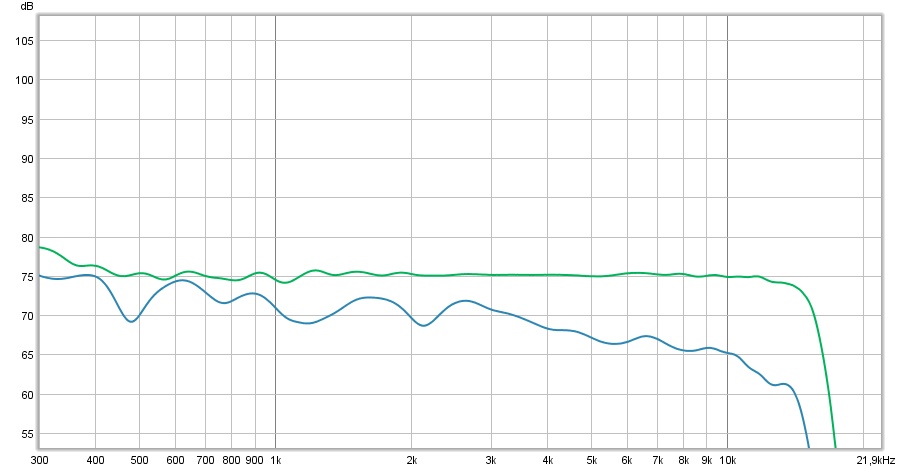
Obviously I've also measured the combined result at that ear:
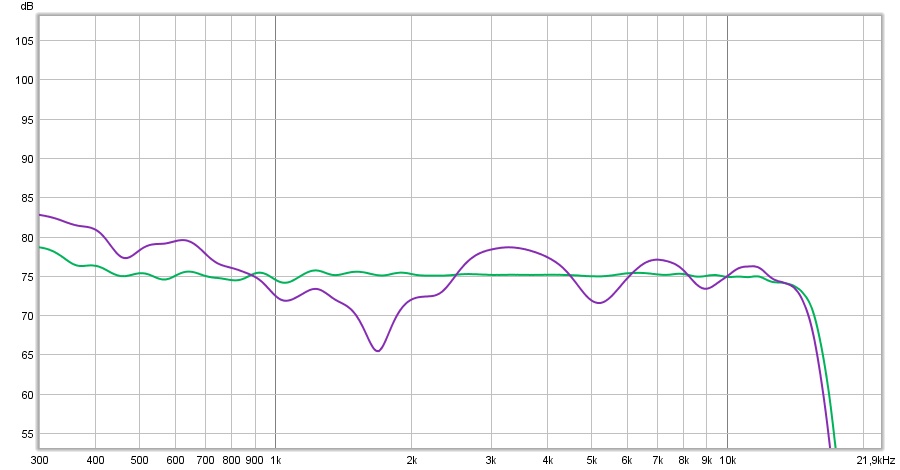
Both graphs above represent a 6 cycle window, no further smoothing.
It's easy to see the cross talk being quite high right at the point where it has the most influence. Obviously this wasn't my exact head, so it's easy to see some fluctuation in these measurements in the exact amount of shading.
If we look at a longer window, lets say 20 cycle, smoothed 1/6 oct it looks like this:
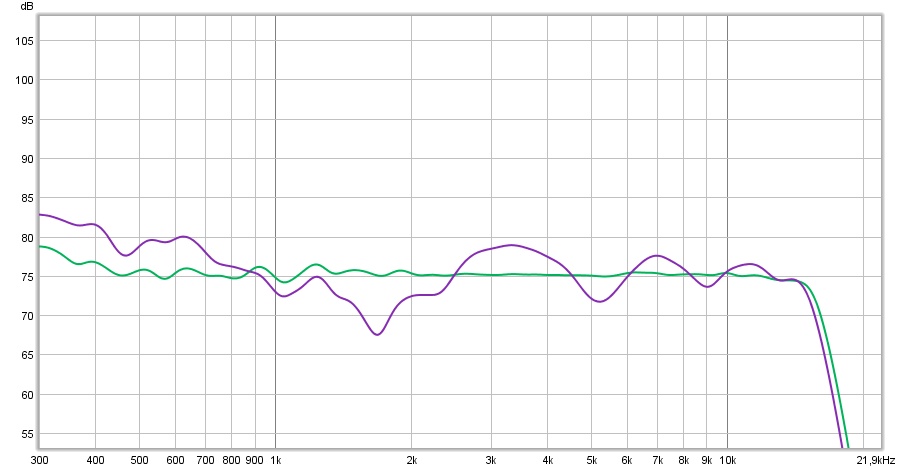
That's where the room treatment and array behavior show their strengths. It's almost a spitting image for the graph above with the 6 cycle window.
This won't happen in a room with lots of early reflections. It's also the root cause which makes it possible to clearly hear this phenomenon.
I'm still surprised how little attention this part of stereo listening is receiving.
I see a lot of people worrying about tweeter quality or the best midrange driver, the distortion etc... but even the worlds best speaker will still have this cross talk happen at the listening position, unless one sticks with a mono setup.
It could very well be a little different between different speaker types such as Horns, ribbons etc. There will also be differences depending on distance and angle to the speakers, which is why Ambiophonics is using a setup with the speakers placed close together. That way it is pushing the first frequency that suffers from this cross talk up in the range.
While I'm playing with possible cures, or at least trying do lessen the effects, I'm hoping there will be a bit more awareness of the effects of this cross talk.
Think about the often used BBC dip etc. Or perhaps the reason why most of the preferred house curves show a bend around ~1500-2000 Hz. Am I the only one that worries/thinks about things like this? 😀
** maybe I should put up a warning too, that these speakers don't bend off that wildly beyond 15 KHz, but these graphs sure make it look like that **
A 500 ms window with 1/48 smoothing might show that it continues beyond the 15 KHz figure:
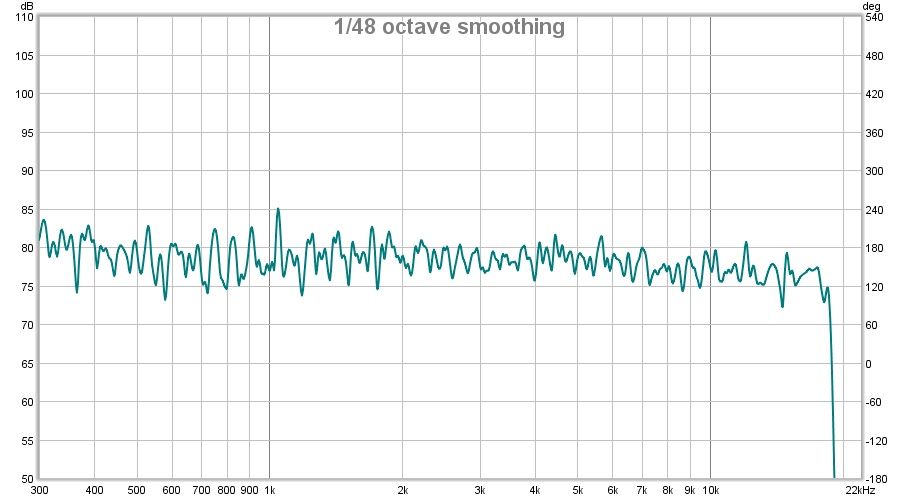
Anyway, what I was trying to say, the cross talk level is actually a bit higher now that I've had a chance to EQ at head/ear positions, here's what I measured at the right ear, featuring the main signal and the separately measured cross talk from the left speaker at that ear:
Obviously I've also measured the combined result at that ear:
Both graphs above represent a 6 cycle window, no further smoothing.
It's easy to see the cross talk being quite high right at the point where it has the most influence. Obviously this wasn't my exact head, so it's easy to see some fluctuation in these measurements in the exact amount of shading.
If we look at a longer window, lets say 20 cycle, smoothed 1/6 oct it looks like this:
That's where the room treatment and array behavior show their strengths. It's almost a spitting image for the graph above with the 6 cycle window.
This won't happen in a room with lots of early reflections. It's also the root cause which makes it possible to clearly hear this phenomenon.
I'm still surprised how little attention this part of stereo listening is receiving.
I see a lot of people worrying about tweeter quality or the best midrange driver, the distortion etc... but even the worlds best speaker will still have this cross talk happen at the listening position, unless one sticks with a mono setup.
It could very well be a little different between different speaker types such as Horns, ribbons etc. There will also be differences depending on distance and angle to the speakers, which is why Ambiophonics is using a setup with the speakers placed close together. That way it is pushing the first frequency that suffers from this cross talk up in the range.
While I'm playing with possible cures, or at least trying do lessen the effects, I'm hoping there will be a bit more awareness of the effects of this cross talk.
Think about the often used BBC dip etc. Or perhaps the reason why most of the preferred house curves show a bend around ~1500-2000 Hz. Am I the only one that worries/thinks about things like this? 😀
** maybe I should put up a warning too, that these speakers don't bend off that wildly beyond 15 KHz, but these graphs sure make it look like that **
A 500 ms window with 1/48 smoothing might show that it continues beyond the 15 KHz figure:
Attachments
Last edited:
In one word: no!
The distances between the time of flight of the signals change off axis, which means the cross talk dips move too. However, the dips at each ear don't line up anymore and our brain does a good job of summing these differences.
Only in the exact sweet spot is the signal at both ears the same, both showing these dips at exactly the same spot, this way enhancing the differences in balance.
I only apply the cross talk to the phantom sounds (so it's still a mid/side EQ variation) and subtract some of this EQ for side panned sounds.
Side panned sounds, if we take the extreme sounds panned hard left (or right) don't have the similar output at the other speaker, so there's nothing that creates these dips at that ear. It (the sound) will still travel to the opposing ear and we sum that signal to determine origin and tonal balance.
By sending an opposing EQ to the sides, about half the strength of the EQ scheme the mid gets, the balance for side panned sounds gets restored.
We can play with that level of EQ applied to the sides, it will alter the perceived location of left panned sounds.
What I'm trying to do here is restore the balance of the signal due to mimicking how it would arrive at the ear as if it was coming from straight forward (for phantom sounds).
One can do the same for the side panned sounds, this way influencing the perception of those sounds as if they came from the side, rather than coming from the speaker location.
The above rambling is also my primary reason to keep my foot down on the importance of phase (and the lack of phase lag due to crossovers). By restoring these signals as they were meant to be heard, you get that binaural effect you can hear on headphones. But much more fun!
It isn't easy and it begins by creating a large reflection free (or at least down far enough) zone in those important first milliseconds. I aimed for the first ~15 to 20 ms being as clear as I could get it.
Combined with this mid/side EQ this creates a holographic kind of imaging with space, depth and a lovely tonal balance.
The beauty of it is that it is acting independent from the room, meaning it will vary with the content being played ("you are there"). Where in a less treated room, one can get satisfying sound and great imaging, but it might be/sound like the same trick on each song ("they are here").
I'm all for the: "you are there" kind of presentation. That's what most of my experiments were geared at, also the reason I'm still playing with it after all these years. It is so worth it! You get a dynamic feel of being there, witness to the recording itself.
Sorry for the ramble. It takes too much time to make measurements that show you what happens off axis, but they are already here somewhere in this thread. In fact, the shuffler from the phantom center thread worked largely on that idea, by creating a slightly different mix at both ears in the phantom sweet spot. I still use that (for now) for Home Theater.
The distances between the time of flight of the signals change off axis, which means the cross talk dips move too. However, the dips at each ear don't line up anymore and our brain does a good job of summing these differences.
Only in the exact sweet spot is the signal at both ears the same, both showing these dips at exactly the same spot, this way enhancing the differences in balance.
I only apply the cross talk to the phantom sounds (so it's still a mid/side EQ variation) and subtract some of this EQ for side panned sounds.
Side panned sounds, if we take the extreme sounds panned hard left (or right) don't have the similar output at the other speaker, so there's nothing that creates these dips at that ear. It (the sound) will still travel to the opposing ear and we sum that signal to determine origin and tonal balance.
By sending an opposing EQ to the sides, about half the strength of the EQ scheme the mid gets, the balance for side panned sounds gets restored.
We can play with that level of EQ applied to the sides, it will alter the perceived location of left panned sounds.
What I'm trying to do here is restore the balance of the signal due to mimicking how it would arrive at the ear as if it was coming from straight forward (for phantom sounds).
One can do the same for the side panned sounds, this way influencing the perception of those sounds as if they came from the side, rather than coming from the speaker location.
The above rambling is also my primary reason to keep my foot down on the importance of phase (and the lack of phase lag due to crossovers). By restoring these signals as they were meant to be heard, you get that binaural effect you can hear on headphones. But much more fun!
It isn't easy and it begins by creating a large reflection free (or at least down far enough) zone in those important first milliseconds. I aimed for the first ~15 to 20 ms being as clear as I could get it.
Combined with this mid/side EQ this creates a holographic kind of imaging with space, depth and a lovely tonal balance.
The beauty of it is that it is acting independent from the room, meaning it will vary with the content being played ("you are there"). Where in a less treated room, one can get satisfying sound and great imaging, but it might be/sound like the same trick on each song ("they are here").
I'm all for the: "you are there" kind of presentation. That's what most of my experiments were geared at, also the reason I'm still playing with it after all these years. It is so worth it! You get a dynamic feel of being there, witness to the recording itself.
Sorry for the ramble. It takes too much time to make measurements that show you what happens off axis, but they are already here somewhere in this thread. In fact, the shuffler from the phantom center thread worked largely on that idea, by creating a slightly different mix at both ears in the phantom sweet spot. I still use that (for now) for Home Theater.
Thanks for the detailed response. Will read it again to make sure I understand what was being said. I'm also going for the "you are there" presentation.
I do wonder about the phase though. In my experience it is not the absolute phase that matters but relative phase. Taking 2 measured speakers with phase wrap as long as the phase is "exactly the same", I think the relative phase changes that you are applying would have the same effect. With no phase wrap it would be easier to interpret changes though.
But simply conjecture on my part. With my very limited tests regarding phase wrap vs no phase wrap I had great difficulty in telling the difference. I'm almost certain I could not pass a blind test. Had trouble with the sighted tests!
I do wonder about the phase though. In my experience it is not the absolute phase that matters but relative phase. Taking 2 measured speakers with phase wrap as long as the phase is "exactly the same", I think the relative phase changes that you are applying would have the same effect. With no phase wrap it would be easier to interpret changes though.
But simply conjecture on my part. With my very limited tests regarding phase wrap vs no phase wrap I had great difficulty in telling the difference. I'm almost certain I could not pass a blind test. Had trouble with the sighted tests!
True, up to a certain part. But I am focussing on phase following the bandpass behaviour of the frequency at my listening spot.
Though these changes aren't as obvious in a test, a headphone test being next to useless, a speaker test would take a lot of work to get right due to floor bounce, early reflections etc.
We observe the world around us by picking up minute differences in timing. How can it not be important to have that part right? As it makes up the harmonic structures of the sound we hear! I have heard differences, that I thought weren't large enough to pick up on. It isn't even all about hearing, but also feeling the beat and other frequencies. Even our eye lids assist in analysing the sounds we hear.
The difference between phase wrap and no phase wrap, while listening to a stereo pair will also be handicapped further by the cross talk problem. Combatting that part results in an entirely different kind of perception.
Basically phase not following the band pass behaviour could also be called time distortion. I have always favoured lower order crossovers or none at all in listening.
But to really have a shot at perceiving the differences, one would need to have the room cooperate. Why no headphones? Because that shuts down a whole lot of our body, that would otherwise help our auditory system make sense of what was heard.
What I do get is more realism. It isn't the biggest factor in the whole game, but phase does behave kind of like 'vector information' would, a steering factor. The more it lines up, the more realism is perceived. It's a part of it, I don't even doubt that anymore. But it needs a lot more help to get all the benefits or one should accept mono sound and experiment with that 😉. Who knows what has been done to the phase in our recordings, there's simply a lot of it out of our control.
Going in I had figured phase was one of the biggest things to get right and: boom! Every thing would magically fall into place. Well, that wasn't exactly right...
Though these changes aren't as obvious in a test, a headphone test being next to useless, a speaker test would take a lot of work to get right due to floor bounce, early reflections etc.
We observe the world around us by picking up minute differences in timing. How can it not be important to have that part right? As it makes up the harmonic structures of the sound we hear! I have heard differences, that I thought weren't large enough to pick up on. It isn't even all about hearing, but also feeling the beat and other frequencies. Even our eye lids assist in analysing the sounds we hear.
The difference between phase wrap and no phase wrap, while listening to a stereo pair will also be handicapped further by the cross talk problem. Combatting that part results in an entirely different kind of perception.
Basically phase not following the band pass behaviour could also be called time distortion. I have always favoured lower order crossovers or none at all in listening.
But to really have a shot at perceiving the differences, one would need to have the room cooperate. Why no headphones? Because that shuts down a whole lot of our body, that would otherwise help our auditory system make sense of what was heard.
What I do get is more realism. It isn't the biggest factor in the whole game, but phase does behave kind of like 'vector information' would, a steering factor. The more it lines up, the more realism is perceived. It's a part of it, I don't even doubt that anymore. But it needs a lot more help to get all the benefits or one should accept mono sound and experiment with that 😉. Who knows what has been done to the phase in our recordings, there's simply a lot of it out of our control.
Going in I had figured phase was one of the biggest things to get right and: boom! Every thing would magically fall into place. Well, that wasn't exactly right...
^Are you trying to counteract the basics of stereophonic phantom image? Interferences because of delay/phase shift and their consequencies are fundamental for that.
Last edited:
Nope, I'm using it to my benefit. And trust me, if it didn't work I wouldn't have chased it for so long! 😀
Ever wondered why so many people prefer mono? Or single driver setups? Or even Open Baffle? Why others prefer horns? Why sometimes wider dispersion wins over narrow and controlled dispersion?
There's a clear answer for any of those questions. That is what I'm playing with. Just without the hassle of constantly changing speaker setups and praying for the best. Improve what you've got, but first come to terms with the why. Learn what measurements tell you, don't fall for the excuse you can't measure your way to better sound. All it takes is learning what to look for/at.
I promise I'm not using anything Blumlein didn't already know about 😉.
What I do falls in a similar category as Ambiophonics, it isn't that hard grasp once you realize the why. You keep your interferences, I'm quite happy without the early ones. Though I do welcome the late arriving ones at about 15 ms or later.
Ever read about the Center channel project from Linkwitz? Or his Watson experiment? Those were similar missions which were also depending on stereo to succeed. The fact that it didn't quite work out had nothing to do with the idea being wrong, there are/were several others that had more success with something very similar. Me? I just try to satisfy me.
As long as this keeps the smiles per minute index high, gives me the chills I need and sucks me into my favourite music, I'll carry on.
If this gets me a stronger, more believable phantom center, better tonality across the stage (L-C-R) and way better imaging throughout, then why not do it? It makes just about any recording shine. Not a few chosen ones. Yes it takes some work, that's why I call it a hobby, right?
Another read that just might make the things I do more clear: The-Magic-in-2-Channel-Sound
Not that I agree with every point made on that page, I have come to different conclusions about a lot of these details.
I don't quite agree with the above. I do find vertical directivity important, as I want to exclude any floor/ceiling bump from my listening experience.
I do agree with the even response from the room, simple means (damping panels) got me there.
Agree completely
Nope, Don't agree with that one, I just make sure there are no early reflections, done trough other means. My speakers don't radiate from the rear.
I like to have more than 6 ms of a RFZ. In fact about 15 ms worth.
Not what I'd recommend either, Dead end behind the speakers, live end on the other side. Now why would Linkwitz use Ambient speakers if he did not want sound coming from the rear?
Agree with that too.
Ever wonder why a Studio features a RFZ (Reflection Free Zone)? Ever wondered why they no longer prefer a Haas Kicker, while it had been "in style" many many moons ago? All the more reason for me to have one.
Ever wondered why so many people prefer mono? Or single driver setups? Or even Open Baffle? Why others prefer horns? Why sometimes wider dispersion wins over narrow and controlled dispersion?
There's a clear answer for any of those questions. That is what I'm playing with. Just without the hassle of constantly changing speaker setups and praying for the best. Improve what you've got, but first come to terms with the why. Learn what measurements tell you, don't fall for the excuse you can't measure your way to better sound. All it takes is learning what to look for/at.
I promise I'm not using anything Blumlein didn't already know about 😉.
What I do falls in a similar category as Ambiophonics, it isn't that hard grasp once you realize the why. You keep your interferences, I'm quite happy without the early ones. Though I do welcome the late arriving ones at about 15 ms or later.
Ever read about the Center channel project from Linkwitz? Or his Watson experiment? Those were similar missions which were also depending on stereo to succeed. The fact that it didn't quite work out had nothing to do with the idea being wrong, there are/were several others that had more success with something very similar. Me? I just try to satisfy me.
As long as this keeps the smiles per minute index high, gives me the chills I need and sucks me into my favourite music, I'll carry on.
If this gets me a stronger, more believable phantom center, better tonality across the stage (L-C-R) and way better imaging throughout, then why not do it? It makes just about any recording shine. Not a few chosen ones. Yes it takes some work, that's why I call it a hobby, right?
Another read that just might make the things I do more clear: The-Magic-in-2-Channel-Sound
Not that I agree with every point made on that page, I have come to different conclusions about a lot of these details.
For the magic to occur there are five requirements, which I have found to be essential:
1) The off-axis frequency response of the loudspeaker in the horizontal plane must mimic the on-axis response. The vertical polar response is not as critical but the formation of lobes should be avoided, i.e. the loudspeaker should be acoustically small. Such a loudspeaker has a neutral signature and its reflections and the reverberated sound field will have the spectral signature of the listening room. The polar pattern could be omni-directional, cardioid or dipolar with frequency independent power response. The omni pattern would produce the strongest interaction with the room and be the least desirable of the three.
I don't quite agree with the above. I do find vertical directivity important, as I want to exclude any floor/ceiling bump from my listening experience.
I do agree with the even response from the room, simple means (damping panels) got me there.
2) The loudspeakers must be free of resonant radiation such as coming from vents or panels. Non-linear distortion must be low enough not to identify the speaker location during loud music passages. This demands adequate volume displacement capability of woofers and tweeters.
Agree completely
3) The loudspeakers must be set up at least 1 m distance from left and right side walls and 1 m from the wall behind them. The resulting time delay of about 6 ms is necessary for the ear-brain perceptual apparatus to separate direct from reflected sound streams. With neutral excitation of the room response, the listener can then withdraw attention from the room and process primarily the direct sound streams from the loudspeakers. This is similar to not hearing the ticking clock or to the cocktail party effect where attention and hearing is drawn to information streams of interest. Everything else is moved beyond the acoustic horizon as in survival mode.
Nope, Don't agree with that one, I just make sure there are no early reflections, done trough other means. My speakers don't radiate from the rear.
I like to have more than 6 ms of a RFZ. In fact about 15 ms worth.
4) The wall behind the loudspeakers is preferably diffusive and the wall behind the listener absorptive. The sound waves from the loudspeaker should be allowed to travel freely past the listener and not be reflected from a wall behind.
Not what I'd recommend either, Dead end behind the speakers, live end on the other side. Now why would Linkwitz use Ambient speakers if he did not want sound coming from the rear?
5) The listening room should have a reverberation time around 450 ms, i.e. be neither acoustically dead nor overly live but comfortable for conversation and entertainment. If anything it should err in the direction of liveliness.
Agree with that too.
Ever wonder why a Studio features a RFZ (Reflection Free Zone)? Ever wondered why they no longer prefer a Haas Kicker, while it had been "in style" many many moons ago? All the more reason for me to have one.
Last edited:
As long as I'm rambling on, I might as well clear up some other well known sentences I often read on this forum:
Yup, getting them in line isn't quite enough. As Juhazi points out, one tends to start missing the interferences that made it worth listening to before applying all that power. But why stop there? The start of an exiting mission could very well begin with that boring sound! That is, if the boring sound was achieved in a proper manor. As DSP still can't fix all room problems. But it can help make better sounding systems!
You want excitement? Get Open Baffles and follow Linkwitz's advise with a 6 ms back feed from the back of the speakers. Excitement guaranteed! But what you don't get is the best out of each and every song in imaging nor in tonality. Tonality changes, with this early of a back wave. It sounds like "a room". A live one, but still "a room".
A Recording in "a room" to be more precise. Works way better for orchestral stuff than for Pop music / Studio recordings. But in the end, we're just throwing away a lot! Or rather masking it.
So the next step, to get rid of the boring sound could be: add ambience.
If you really have a good, clear speaker setup (trough DSP or hopefully otherwise) and it has a boring quality, add a late tail to it. Reflections from lateral angles timed about 15 to 25 ms behind the mains can do wonders. Keep it about 10 dB to 12 dB (or more) down in level than the fronts and: Bam! We have our excitement back. But this time without that obvious "room stamp" in tonality.
But wait? If I sit in the sweet spot, I now hear a different tonal balance from phantom sounds, compared to the sides! Oh no.... That wasn't there before when I had the reflections coming back at me at about 6 ms?
Yeah... bummer... that's part of Stereo, it is the cross talk biting your @ss.
Can we fix it? Heck yeah... just read this thread, you'll find more than one way! Is it worth it?
Well, you could spend all that time building other speakers and run around in circles once again, while puzzling why the measurements never really do tell you what you hear. But the rewards are that you keep all the excitement of that room with a 6 ms bounce, imaging that adapts to what the song has to offer, tonality to die for and no longer stamps every thing in a similar way and the best thing? It's adding a lot of Realism.
All of this in this post in good fun. The above post is a somewhat short version of what I've gone trough within this thread. Fix one thing, another thing pops up. But the end result has given me all the rewards I could ever wish for, which is why I do it. And why I write about it (with a lot of passion). 🙂
Regular readers will pick up on the journey I made, as it really is what I've gone trough, to find my answers. Well that, and a whole lot more. I wouldn't have missed any part of it though. It has brought with it a lot of listening pleasure, it has been huge fun having fellow members drop by, it has given me these strange online friendships with people I haven't yet met.
Can anyone blame me for simply carrying on? 😀
I don't ask anyone to believe what I write. I simply write down what I try and how it works out for me. Basically I have read a lot of "truth" about audio, but I'm stubborn enough to want to find my own answers. So I do tend to try a lot! And these arrays are not my maiden experience.
What I try is often inspired by reading a lot (that doesn't quite cover it, lol). If anyone is ever without inspiration, something I posted about might be just enough to get that spark going.
DSP made my speakers boring to listen to...
Yup, getting them in line isn't quite enough. As Juhazi points out, one tends to start missing the interferences that made it worth listening to before applying all that power. But why stop there? The start of an exiting mission could very well begin with that boring sound! That is, if the boring sound was achieved in a proper manor. As DSP still can't fix all room problems. But it can help make better sounding systems!
You want excitement? Get Open Baffles and follow Linkwitz's advise with a 6 ms back feed from the back of the speakers. Excitement guaranteed! But what you don't get is the best out of each and every song in imaging nor in tonality. Tonality changes, with this early of a back wave. It sounds like "a room". A live one, but still "a room".
A Recording in "a room" to be more precise. Works way better for orchestral stuff than for Pop music / Studio recordings. But in the end, we're just throwing away a lot! Or rather masking it.
So the next step, to get rid of the boring sound could be: add ambience.
If you really have a good, clear speaker setup (trough DSP or hopefully otherwise) and it has a boring quality, add a late tail to it. Reflections from lateral angles timed about 15 to 25 ms behind the mains can do wonders. Keep it about 10 dB to 12 dB (or more) down in level than the fronts and: Bam! We have our excitement back. But this time without that obvious "room stamp" in tonality.
But wait? If I sit in the sweet spot, I now hear a different tonal balance from phantom sounds, compared to the sides! Oh no.... That wasn't there before when I had the reflections coming back at me at about 6 ms?
Yeah... bummer... that's part of Stereo, it is the cross talk biting your @ss.
Can we fix it? Heck yeah... just read this thread, you'll find more than one way! Is it worth it?
Well, you could spend all that time building other speakers and run around in circles once again, while puzzling why the measurements never really do tell you what you hear. But the rewards are that you keep all the excitement of that room with a 6 ms bounce, imaging that adapts to what the song has to offer, tonality to die for and no longer stamps every thing in a similar way and the best thing? It's adding a lot of Realism.
All of this in this post in good fun. The above post is a somewhat short version of what I've gone trough within this thread. Fix one thing, another thing pops up. But the end result has given me all the rewards I could ever wish for, which is why I do it. And why I write about it (with a lot of passion). 🙂
Regular readers will pick up on the journey I made, as it really is what I've gone trough, to find my answers. Well that, and a whole lot more. I wouldn't have missed any part of it though. It has brought with it a lot of listening pleasure, it has been huge fun having fellow members drop by, it has given me these strange online friendships with people I haven't yet met.
Can anyone blame me for simply carrying on? 😀
I don't ask anyone to believe what I write. I simply write down what I try and how it works out for me. Basically I have read a lot of "truth" about audio, but I'm stubborn enough to want to find my own answers. So I do tend to try a lot! And these arrays are not my maiden experience.
What I try is often inspired by reading a lot (that doesn't quite cover it, lol). If anyone is ever without inspiration, something I posted about might be just enough to get that spark going.
Last edited:
I have often spoken about the desire to rewire my arrays in parallel/series instead of the series/parallel I have chosen. Sims seemed to show a slightly better behavior around Fs, where the total impedance peak could show some slight bumps and dips when wired in series/parallel.
On Fluid's thread, I showed many graphs as a testament of why that would divide the power a bit better, leading to a clean impedance measurement.
With a bit of care, the impedance of series/parallel doesn't have to be bad, but I've always thought that parallel/series was the better choice. On another thread today, mark100 said some stuff that made me check/dig a little deeper.
To my surprise, when connected in parallel/series each driver gets to handle the total amount of power you throw at it! I do remember staring at the thin wire and thinking about it when I first made my arrays. But I had never done the sims to check, except for the series/parallel wiring I have used myself.
I have done many sims prior to building to know/learn what to expect.
Here's a post I made today, where I ran some more Xsim simulations:
As mentioned I figured to put this up on my wall of shame right here. I don't know why I'm the first to run this sim, but in a way I'm still glad I did.
Personally I'm embarrassed and retract my voiced opinion on wiring schemes for full range arrays promoting parallel/series wiring. Stick to series/parallel for way better power dissipation per driver.
I do hope this get's some views/opinions and maybe a couple of "I told you so's" I might have missed? This is the first time I've tested it, while simming and testing a lot about the power handling of series/parallel before my own build. Had I known this earlier I would have never advertised/promoted parallel/series wiring. I hope who ever build an array with parallel/series wiring did the proper research? Keep it to 30 watt max to be save, while I'm sure you'd still have some reserves at those numbers.
On Fluid's thread, I showed many graphs as a testament of why that would divide the power a bit better, leading to a clean impedance measurement.
With a bit of care, the impedance of series/parallel doesn't have to be bad, but I've always thought that parallel/series was the better choice. On another thread today, mark100 said some stuff that made me check/dig a little deeper.
To my surprise, when connected in parallel/series each driver gets to handle the total amount of power you throw at it! I do remember staring at the thin wire and thinking about it when I first made my arrays. But I had never done the sims to check, except for the series/parallel wiring I have used myself.
I have done many sims prior to building to know/learn what to expect.
Here's a post I made today, where I ran some more Xsim simulations:
Was that for indoors? 😱
I don't know what volume you're using or what you're after, but I don't want to be in the room with you.
The 6 dB, translates to 4 watt compared to 1 watt, right? Doubling the power for each dB.
Let's fire up xsim and see, sorry, I used 25 drivers in series parallel because that's what I have in my library.
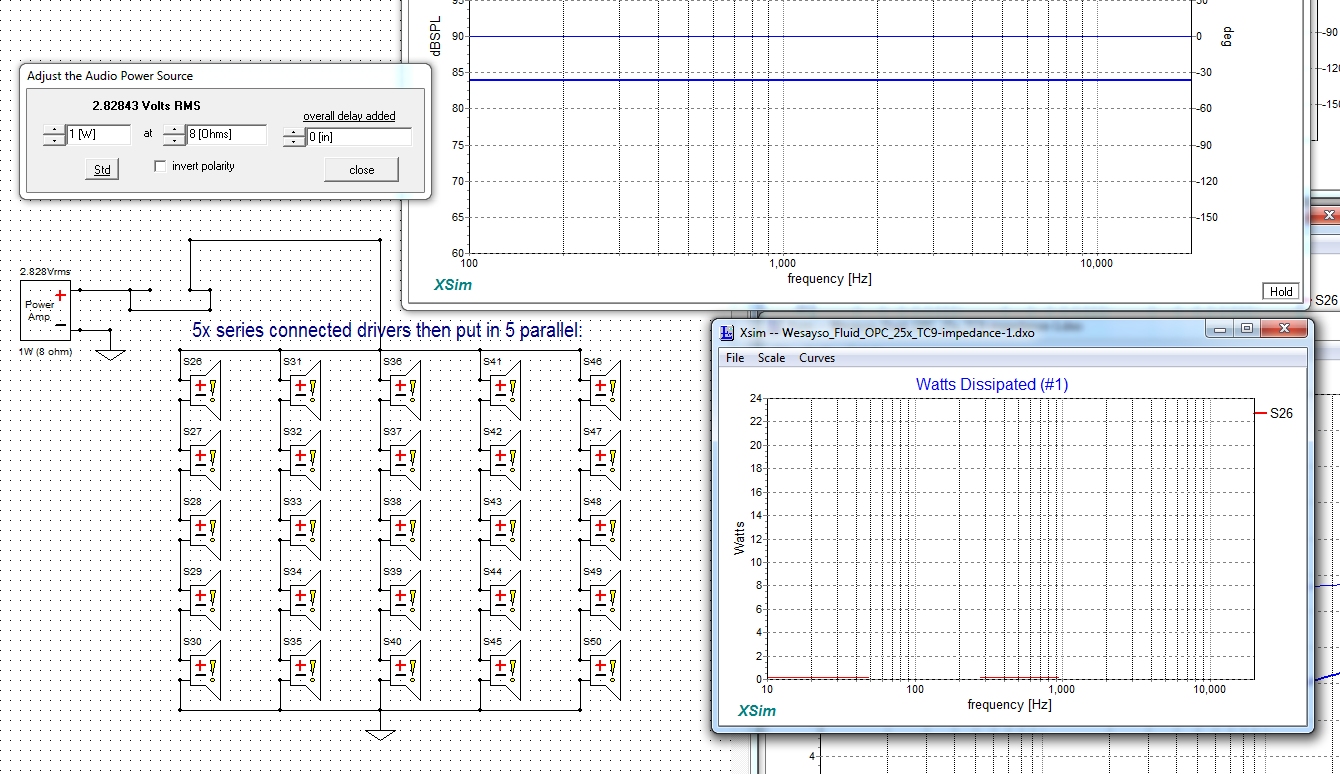
One watt, and the graph for a single driver in that array showing watts dissipated for that driver. Even though the graph says 84 dB for an array of drivers, the array behavior will add about 13 dB at ~200 Hz. At 1 watt it will be close to 97 dB/watt at 300 Hz. Dropping output potential below Fs of course. And dropping 3 dB per octave above that.
Now let's pump up the volume, putting in 4 watt for that 6 dB in gain:
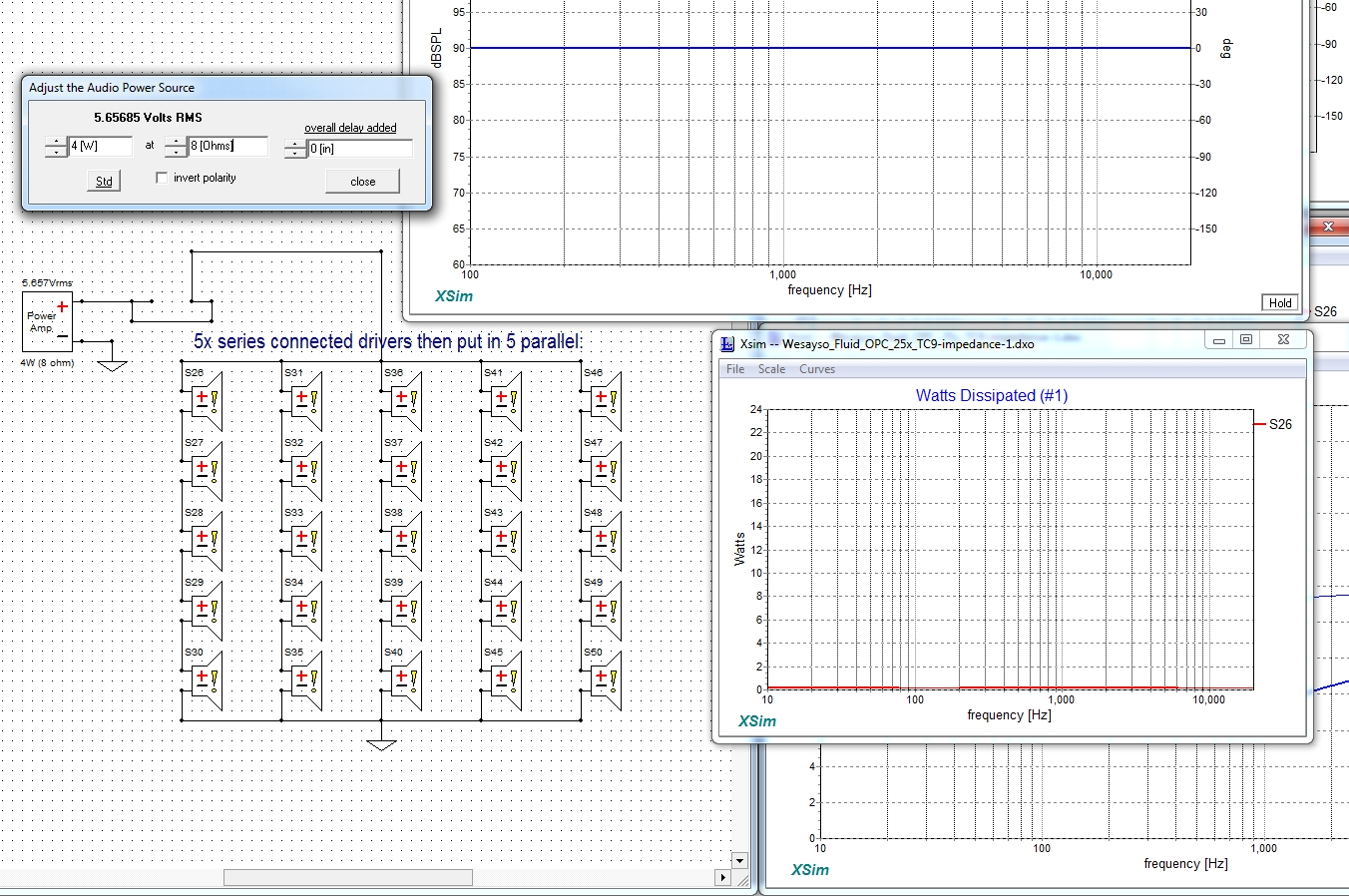
Still barely visible what one driver gets, hence my comment about spreading the load between the drivers.
Let's pump it up, putting in 240 watt, like I claimed it could handle:
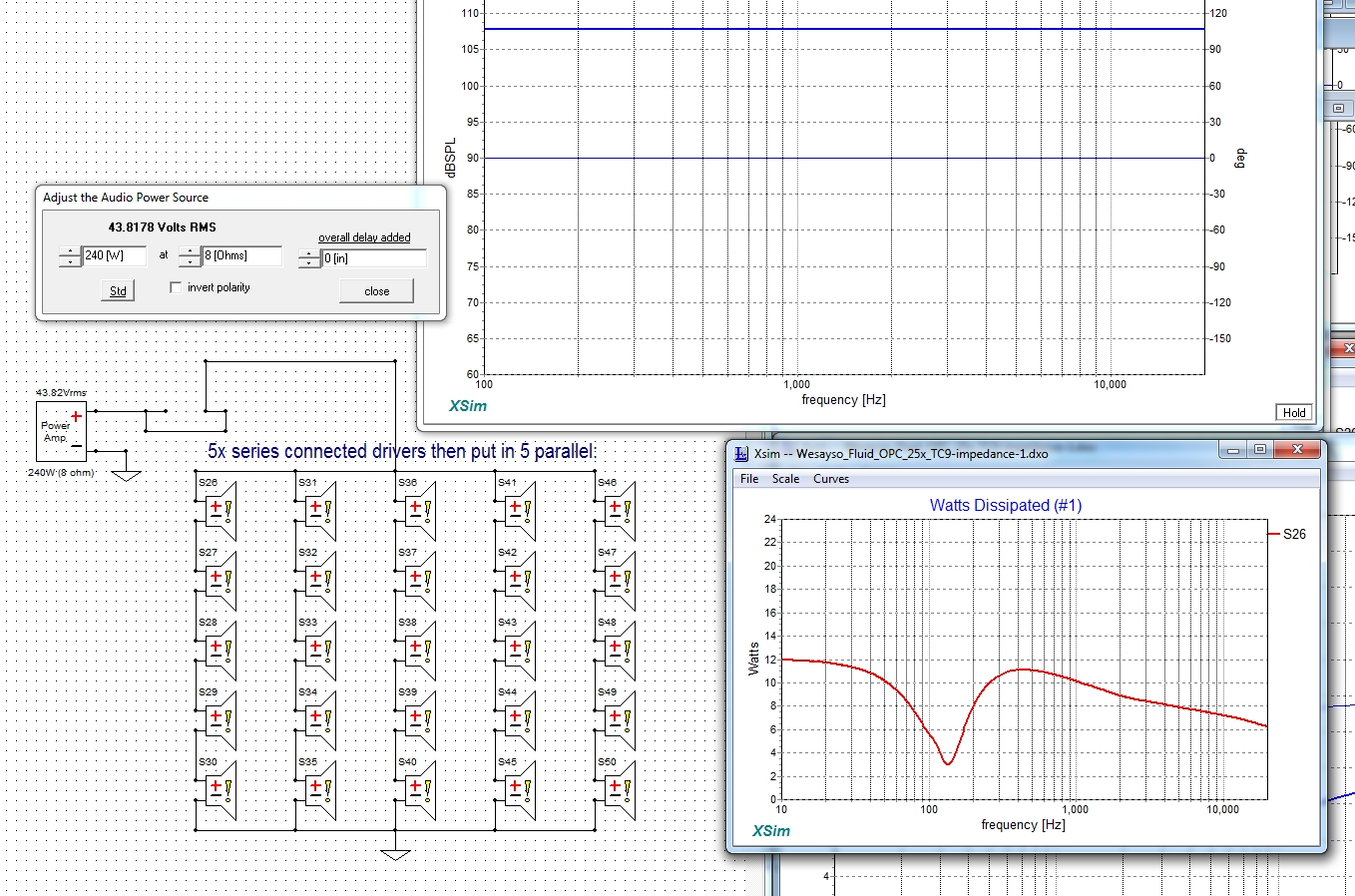
Each driver still get's a fraction of that, in this case: 8 watt at 200 Hz, 10.25 watt at 300 Hz etc. Depending on what version of the countless spec sheets you've got it is advertised as a 30 watt noise power handling per driver,
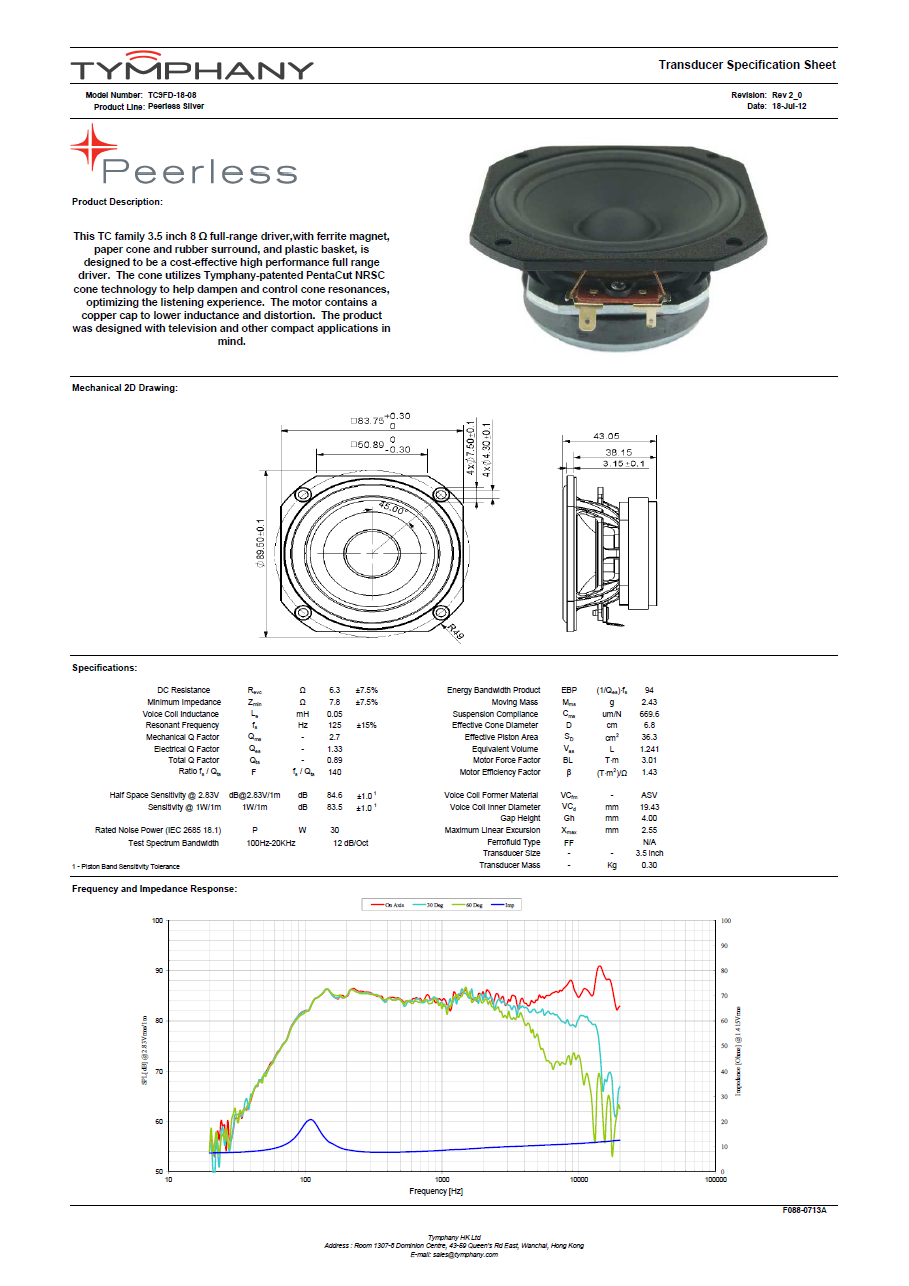
50 watt in rev1:
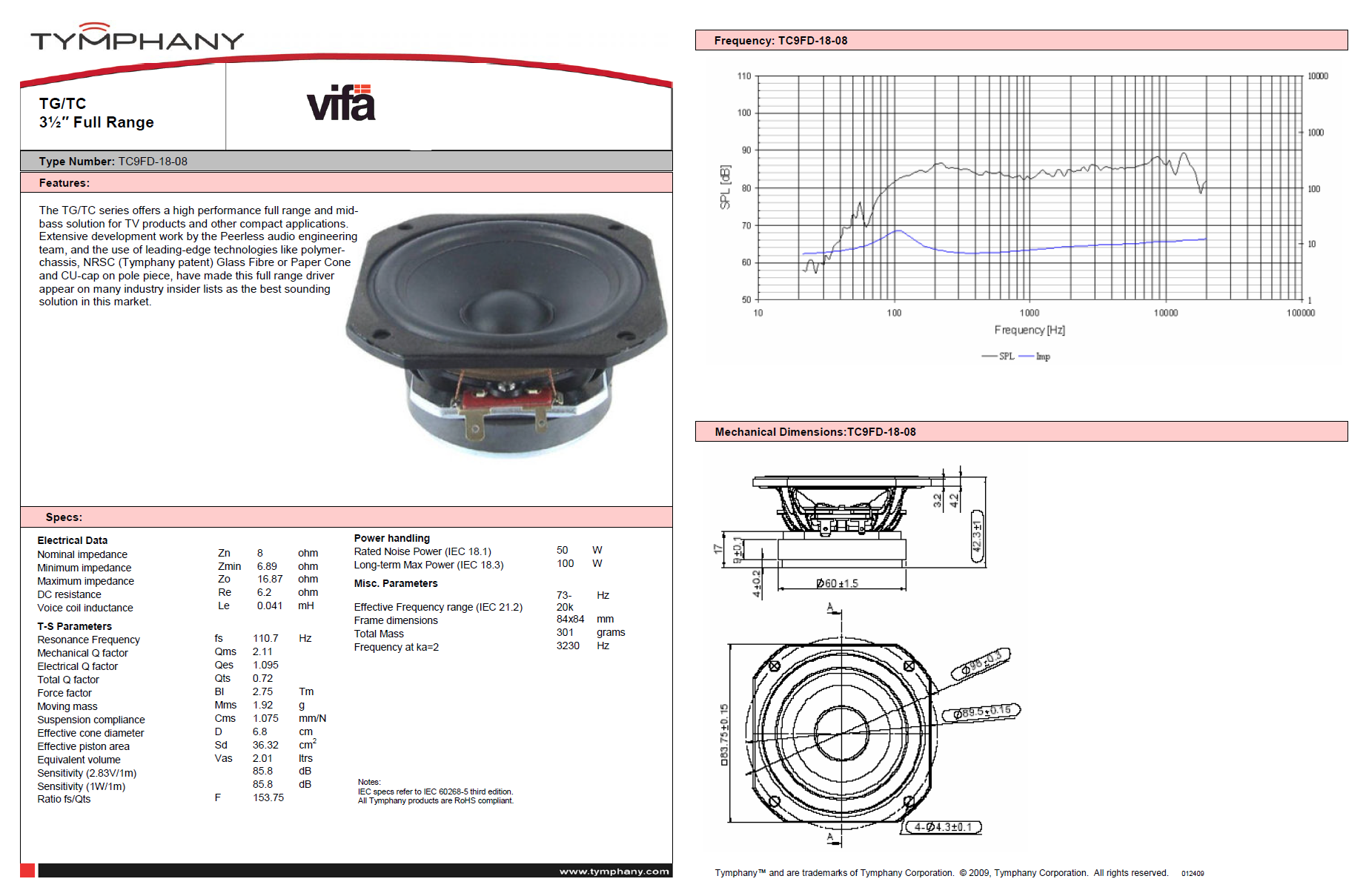
But I've always used 15 watt myself, due to wanting to keep things in one piece while boosting the low end.
The scale says it hits 107 dB, the array behavior will add the 13 dB to that, making it ~120 dB at 200 Hz, and falling off 3 dB each octave above that, where the watts dissipated drop down.
I could have figured you'd pick a healthy 12" driver. I have the Scan Speak 30W with 466 cm3.
Did you connect the drivers in parallel/series? Because I've never checked watts dissipated for that scenario 😱. You could be right in that case.
So maybe this was a gross oversight from my side, thinking I had to rewire to parallel series because of the better behavior/handling at Fs? Is that connection scheme handling the total amount of power in each and every single driver of that array? It would/could explain why you ran into x-max very soon... I honestly never did that math(!) However I would think anyone building it like that would bother to check. I've literary run dozens of sims for my arrays.
Let's check it now:
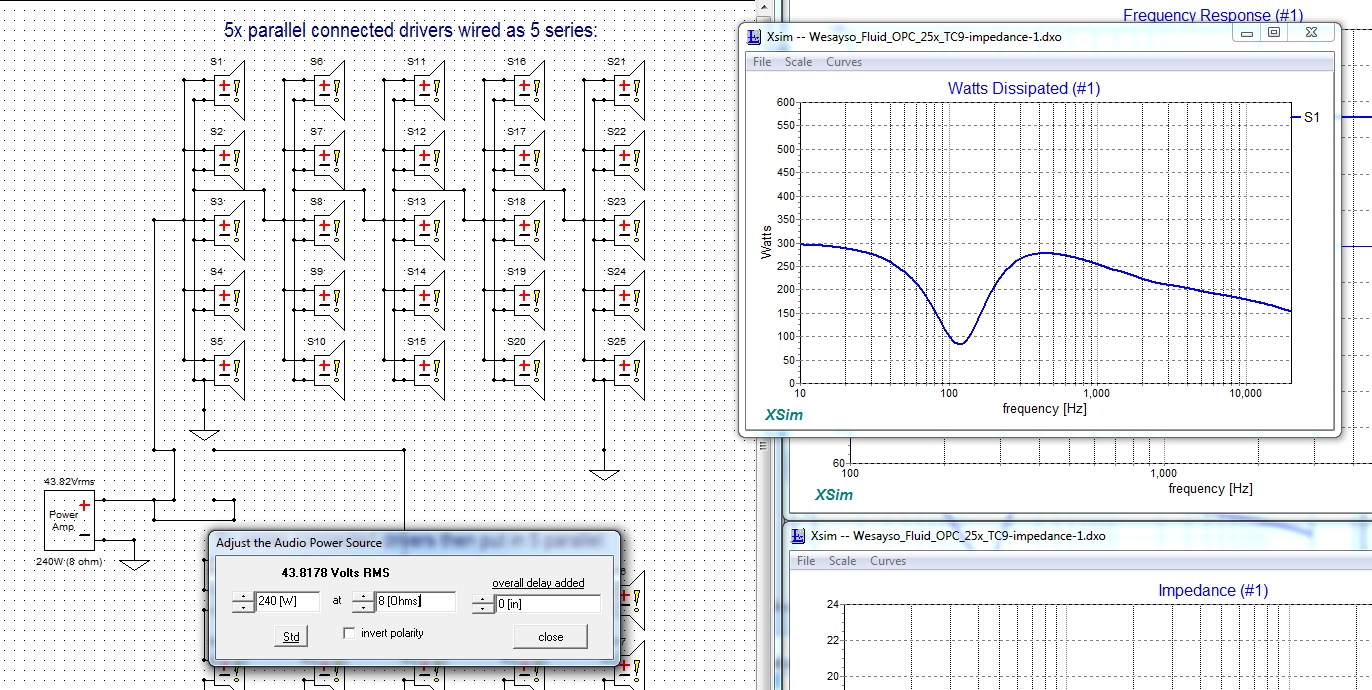
25 drivers in parallel/series with 240 watt, one driver gets the full amount!
That would explain a great deal 😱. It also puts an end to my personal rewiring dreams 😱. (I have to say, I'm pretty sure I would have checked this in advance before rewiring)
I have learned something new today, for that I do thank you. But I feel ashamed/stupid I've never checked this before. Why didn't anyone else ever check this and correct me? For all the times I promoted the wrong schematics? I'll copy and paste this in my thread as a warning!
As mentioned I figured to put this up on my wall of shame right here. I don't know why I'm the first to run this sim, but in a way I'm still glad I did.
Personally I'm embarrassed and retract my voiced opinion on wiring schemes for full range arrays promoting parallel/series wiring. Stick to series/parallel for way better power dissipation per driver.
I do hope this get's some views/opinions and maybe a couple of "I told you so's" I might have missed? This is the first time I've tested it, while simming and testing a lot about the power handling of series/parallel before my own build. Had I known this earlier I would have never advertised/promoted parallel/series wiring. I hope who ever build an array with parallel/series wiring did the proper research? Keep it to 30 watt max to be save, while I'm sure you'd still have some reserves at those numbers.
Last edited:
I have often spoken about the desire to rewire my arrays in parallel/series instead of the series/parallel I have chosen. Sims seemed to show a slightly better behavior around Fs, where the total impedance peak could show some slight bumps and dips when wired in series/parallel.
On Fluid's thread, I showed many graphs as a testament of why that would divide the power a bit better, leading to a clean impedance measurement.
With a bit of care, the impedance of series/parallel doesn't have to be bad, but I've always thought that parallel/series was the better choice. On another thread today, mark100 said some stuff that made me check/dig a little deeper.
To my surprise, when connected in parallel/series each driver gets to handle the total amount of power you throw at it! I do remember staring at the thin wire and thinking about it when I first made my arrays. But I had never done the sims to check, except for the series/parallel wiring I have used myself.
I have done many sims prior to building to know/learn what to expect.
Here's a post I made today, where I ran some more Xsim simulations:
As mentioned I figured to put this up on my wall of shame right here. I don't know why I'm the first to run this sim, but in a way I'm still glad I did.
Personally I'm embarrassed and retract my voiced opinion on wiring schemes for full range arrays promoting parallel/series wiring. Stick to series/parallel for way better power dissipation per driver.
I do hope this get's some views/opinions and maybe a couple of "I told you so's" I might have missed? This is the first time I've tested it, while simming and testing a lot about the power handling of series/parallel before my own build. Had I known this earlier I would have never advertised/promoted parallel/series wiring. I hope who ever build an array with parallel/series wiring did the proper research? Keep it to 30 watt max to be save, while I'm sure you'd still have some reserves at those numbers.
I am not sure what went wrong in your sim of this , and I have not yet gone through the schematics of the two situations, but your conclusion is wrong!!
No matter how you wire them parallel/series or series/parallel each of the speakers will get 1/25 of the total power you present at the total array.
When I look at such problems I always try to take a simple example to show how it works. 4 resistors can be put in parallel/series or in series/parallel and this shows what happens. Dosent matter how many you are dealing with, the situation will be the same. This is Ohms Law and no sim software is going to change that IMHO 😀
Attachments
Last edited:
- Home
- Loudspeakers
- Full Range
- The making of: The Two Towers (a 25 driver Full Range line array)

